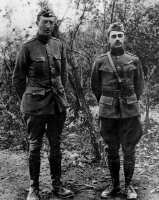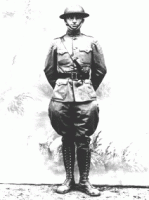OneManGang
Senior Member
- Joined
- Sep 7, 2004
- Messages
- 2,038
- Likes
- 9,674
Tennessee vs The Maxims vs Charlotte
Ah, Homecoming! Parades and floats, Old Grads aplenty, and football.
Two out of three ain't bad.
As an aside: It should worry Alabama fans that, based on Tennessee's offensive stats in the respective games, Charlotte has a better defense than they do.
* * * * * * * * *
The night of 25 September 1918 found three young Americans in France. The first was a young Colonel, a product of the Virginia Military Institute. He found himself now as a staff officer in the First U.S. Army, overseeing the final movements of 600,000 men and nearly 1 million tons of supplies into position for the start of a great offensive.
In the depths of the Argonne Forest a newly-minted battalion commander, Charles Whittesley, and the men of the 1st Battalion, 308th Infantry, 77th Division waited for the morning. Whittesley was a Harvard graduate and had been a very successful attorney in New York before the war.
Finally, a young Captain from Missouri saw to the welfare of his men and the guns of Battery D, 129th Field Artillery. His guns would be firing in the morning.
It would be the biggest battle in American history. On 26 September 1918 the First US Army launched an offensive along a sector of the Western Front stretching from Verdun west for twenty miles. Ten American divisions totaling some 280,000 men plus support troops would kick things off.
They were all part of the American Expeditionary Force. The American Expeditionary Force, or simply AEF, had been formed due to the will and force of one man: General John J. Pershing. Pershing had insisted that as American combat troops deployed to France to help the British and French fight the Germans, those Americans would fight only as Americans and only under American command. Now, finally, after over a year of preparation, the AEF was preparing to enter the big stage of World War One and launch their own “Big Push.”
George Catlett Marshall had come to France as a staff officer with the 1st Division. His work in planning the first American attack of the war at Cantigny in May of 1917 got him noticed by higher headquarters and he found himself promoted to Colonel on the staff of First Army and tasked with organizing the movement of the Army: pulling it out of the major offensive at St. Mihiel, pivoting the entire force 90° then moving the whole mess 50 miles and having it ready to go in less than two days.

(US Army)
Marshall’s plan was good but not flawless and the primitive French road system was a major impediment. Monumental traffic jams jammed every crossroads and then it began to rain. Asphalt paving lay twenty years in the future and the gravel roads simply dissolved. Somehow, though, the First Army made the move and stood ready as the rains finally ceased around just after midnight on the 26th.
Major Charles Whittlesey’s battalion would jump off at dawn with the rest of the 77th Division, in the heart of the vast Argonne Forest. Already, a thick fog and chill air were making the Major’s head cold worse and he could barely speak above a whisper.
The Captain from Missouri held a brief meeting with his cannoneers and concluded, “I want to tell you this, too, fellows. Right tonight I’m where I want to be – in command of this battery. I’d rather be here than President of the United States. You boys are my kind. Now let’s go in!” That battery would fire something around 3,000 rounds of 75mm in the next four hours. They placed wet burlap gunnysacks over the gun barrels to cool them and poured water over them continually – the water boiled. The noise and concussions left the young captain “deaf as a post” for a time.
Any major attack during the Great War was a catastrophe for the attackers and the Meuse-Argonne Offensive was no different.
Sergeant William Triplett, whose 140th Infantry assaulted the village of Cheppy described it, “They’d pushed on with the same esprit as Pickett’s brigade at Gettysburg and with about the same results.”
Major Whittlesey’s battalion had moved out in thick fog and under heavy fire but made good progress. His appointment with destiny would come in a few days.
The attack quickly degenerated into a tangle of units, as untested leaders and doughboys alike got lost, got hit, got wounded, and got killed.
By midnight, the lines had moved a little but not enough to satisfy General Pershing and he issued orders that the attacks continue “regardless of losses.”
Nobody really knows how many doughboys were hit on the 26th of September. Estimates range to over 20,000 or so which would rival the Civil War battle of Antietam as the bloodiest single day of combat in American military history.
… And that was just the first day of an operation that would last until the Armistice on 11 November and involve well over a million doughboys.
On 1 October, Major Whittlesey’s battalion jumped off again. This time they made very good progress and soon out paced the battalions on their left and right. By late afternoon, their situation became apparent, but lacking orders to the contrary, Whittlesey sent out patrols to find other American units and runner to the rear to tell regimental and divisional command where he was. All returned with the same story, there was nobody in any direction who didn’t sprechen anything but deutches. They were surrounded.
Distracted and disorganized, nobody at regimental, brigade or divisional headquarters noticed that an entire battalion had disappeared for over a day. Once they figured that out, it was a question of what to do about it. They still didn’t quite know where Whittlesey’s unit was.
In an epic small-unit battle, Whittlesey and his dwindling band of soldiers resisted German attack after German attack, were pounded by artillry (both German and French) turned down an offer of “honorable surrender” and hung on by their fingernails until a relief operation finally broke through FIVE DAYS LATER. Out of the 570 or so doughboys that wound up in the pocket, 194 survived. Whittlesey was awarded the Congressional Medal of Honor. He accepted on behalf of his men.

Major Charles Whittlesey (on left) (US Army)
The agony went on. The offensive finally began to gain significant ground as the German army began to collapse in late October, but casualties were still horrific. Many a doughboy who had survived earlier fights died in the last hours of the war as American units scrambled to cross the Meuse River and take Sedan before the Armistice. It was pointless. The documents had already been signed and generals had shaken hands. At 1100 on 11 November “the eleventh hour of the eleventh day of eleventh month” the guns fell silent.
The killing was over. The dying and suffering went on.
Near Romagne, France is the Meuse-Argonne American Cemetery. 14,246 doughboys lie there. It is the largest American military cemetery in Europe. In its statistical analysis of the Great War, the US Army noted that in the last six weeks of the war, the AEF averaged 6,000 - SIX THOUSAND – men killed in action PER WEEK. A high percentage of those fell in the tangle of the Meuse-Argonne.
George Catlett Marshall would go on to become Chief of Staff of the US Army during WWII, commanding the largest land force in American history. He continued to serve afterwards as Secretary of State, lending his name a massive recovery effort in Europe. He died in 1959 and was buried in a simple soldier’s grave not far from the Tomb of the Unknowns at Arlington.
Major Charles Whittelsey came back to New York and tried to pick up where he left off, but the memories of those days cut off behind enemy lines would haunt him. In 1926, he boarded ship for a trip to Havana. Somewhere along the way one night, he simply jumped over the side and was never seen again.
Our young artilleryman would return home, open a clothing store that soon folded, and eventually enter politics. He rose to the U.S. Senate and then was selected to be Franklin Roosevelt’s running mate in 1944. Upon FDR’s death the following April, the former doughboy, Captain Harry Truman of Battery D, 129th Field Artillery, raised his right hand and was sworn in as President of the United States.
*********
So how did the team do compared to the Maxims?
1. The team that makes the fewest mistakes will win.
Charlotte's error would seem to be a failure to recruit offensive players to match their defensive unit
2. Play for and make the breaks. When one comes your way … SCORE!
Proving himself a master of understatement, in his post-game presser HeadVol Pruitt said, “We didn’t make any explosive plays, and we struggled to be consistent and run the football, and that’s not a very good recipe for success.”
3. If at first the game – or the breaks – go against you, don’t let up … PUT ON MORE STEAM!
Note to the 2018 Vols: the “more steam” referred to here does not reference sandwiches at Gus's Deli. Thank you.
4. Protect our kickers, our quarterback, our lead and our ballgame.
Charlotte's Alex Highsmith had his arms around Jarrett Guaratano so often I thought they would be announcing their engagement after the game.
5. Ball! Oskie! Cover, block, cut and slice, pursue and gang tackle … THIS IS THE WINNING EDGE.
Twenty. Two-zero. 20 yards rushing on 26 attempts. Has it truly sunk in to Vol fans that, until somewhere in the 4th canto, UT had NEGATIVE rushing yards? Those vibrations near Central Ave. Saturday were the Gen'rul rolling over in his grave. That said, the Vol defense seemed to have an answer for anything Charlotte could cook up.
6. Press the kicking game. Here is where the breaks are made.
Marquez Callaway.
7. Carry the fight to Charlotte and keep it there for sixty minutes.
More like just the first quarter but it was enough.
Elder Son&Heir and I went to the BasketVols' tilt with Tusculum Wednesday night and the similarities with Saturday's contest were apparent. Both Vol teams came out flat and played with little fire or emotion. The difference was that the hoopsters have talent to burn and buried Tusculum whilst the football team does not and could not.
MAXOMG
© 2018 Keeping Your Stories Alive
Suggested Reading:
Byron Farwell, Over There
Thomas Johnson and Fletcher Pratt, The Lost Battalion
Laurence Stallings, The Doughboys

Capt. Harry Truman (US Army)



